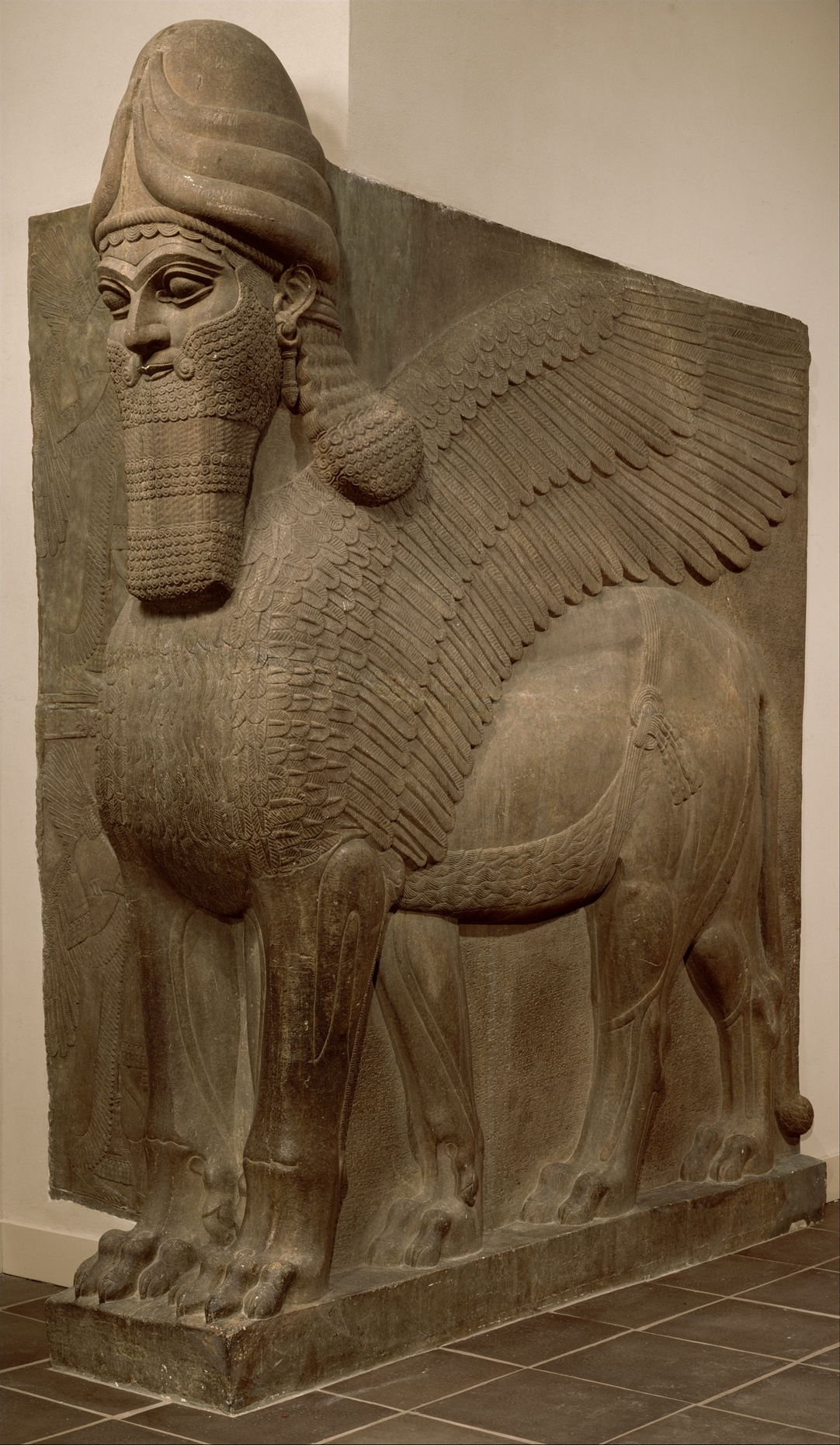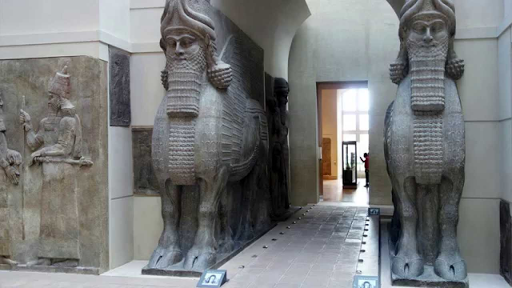To protect the household Lamassu were engraved in clay tablets and the tablet would then be buried under the doors threshold. Where were the lamassu sculptures originally displayed Hermaphroditus was actually a popular subject of paintings and statuary even if Written By whitehouse March 11 2022 Add Comment Edit.

Lamassu The Ancient Assyrian Winged Bull Protective Goddess
On a larger scale Lamassu would also flank the entrances of palaces as colossal sculptures in high relief in pairs.

. Sargons palace Gudeas Lagash Ashurbanipals palace Ziggurat at Ur Advertisement ashleyalfaro46p5nook is waiting for your help. Which is the oldest work. The first Lamassu appeared under Tiglath-Pileser in the 900s BCE.
A- sargons palace Advertisement Survey Did this page answer. For this reason it is not an entirely freestanding sculpture. Originally unearthed in Rome and displayed in the Borghese Gallery it was sold to the occupying French and now sits in the Louvre.
The Ziggurat at Ur was a fortress funerary monument palace temple platform Where were the Lamassu sculptures originally displayed. Columns with animals as capitals Egyptians used all of the following excep engaged columns with disc-shaped capitals. Answer 38 5 7 aquadiamond the answer is.
The emperor portrayed in San Vitale is pendentives The dome of Hagia Sophia is supported by 6th century CE The earliest well-preserved illuminated manuscript containing scenes from the Bible the Vienna Genesis dates from the Santa Costanza Which is not a basilica-plan structure. Lamassu frequently appear in Mesopotamian art and mythology. The Lamassu ase later bought by British Resident Sir Henry Rawlinson in 1849 and sad into smaller lighter.
Akkadia Catal Huyuk Jericho Sumeria The Ziggurat at Ur was a fortress funerary monument palace temple platform Where were the Lamassu sculptures originally displayed. Originally unearthed in Rome and displayed in the Borghese Gallery it was sold to the occupying French and now sits in the Louvre. The Ziggurat at Ur was a fortress funerary monument palace temple platform Where were the Lamassu sculptures originally displayed.
The winged beasts from Nimrud in Iraq the ancient city of Kalhu also became quite famous. Some of the Sculptures here brought back to the Louvre in France to be put on display however the two massive Lamassu weighing sixteen tons each were too heavy to be transported. Lamassu were placed on either side of the doorways of Assyrian palaces and of gateways to cities to protect against evil spirits and impress the neighbors.
Assyrian sculpture typically placed prominent pairs of lamassu at entrances in palaces facing the street and also internal courtyards. The first change was the capital was moved to Dur Sharrukin present day Khorsabad and second the Lamassu was presented on a bulls body compared to a lions and seems to be slightly smiling. Old Saint Peters SantApollinare Nuovo Santa Costanza Santa Sabina.
Originally unearthed in Rome and displayed in the Borghese Gallery it was sold to the occupying French and now sits in the Louvre. The first recorded Lamassu comes from ca. Click to see full answer Furthermore where were the lamassu sculptures originally displayed.
However it is displayed in a museum in its original context a lamassu is the guardian of a doorway integral with a wall. Sargons palace Gudeas Lagash Ashurbanipals palace Ziggurat at Ur Which culture is credited with the first system of writing known to humanity. Where were the lamassu sculptures originally displayed Written By viveiros Friday March 11 2022 Add Comment Edit Terracotta artwork was the standard for decorating the superstructure of Etruscan temples and the coroplastic terracotta workshops producing these sculptures often displayed a high level of technical achievement.
An American professor named Michael Rakowitzwas commissioned to recreate this Lamassu sculpture and it is now displayed in Trafalgar Square in London. During the operation of the British military in Iraq and Iran in 1942-1943 the British even embraced Lamassu as their emblem. This replica was made with 10000 Iraqi date syrup cansand serves as a symbol of.
The Assyrian sculpture was discovered in northern Iraq when archaeologists from the OI including Edward Chiera were excavating at Khorsabad Dur-Sharrukin in 1929. 1Head of an Akkadian ruler 2 Palace of Sargon II 3 Stele of Hammurabi 4 Seated Gudea Head of an Akkadian ruler What architectural feature do we find at Persepolis and nowhere else in Mesopotamia. The British Museum was the first public national museum in the world.
Appreciating and understanding ancient Egyptian art. It appears frequently in Mesopotamian artThe lamassu and shedu were household protective spirits of the common Assyrian people becoming associated later as royal protectors and were placed as sentinels. The Lamassu sculptures were recovered from where.
The gate and its lamassu were first excavated by Sir Austen Henry Layard in 1849 but then re-buried. They most often appear in pairs carved on either side of the entrances into royal palaces which they were believed to protect from evil. The lamassu is a celestial being from ancient Mesopotamian religion bearing a human head bulls body sometimes with the horns and the ears of a bull and wings.
Add your answer and earn points. This winged-bull known as a lamassu from textual sources was given to the OI by the Department of Antiquities in Iraq. Under the reign of two great Assyrian kings known as Ashurnasirpal II and Sargon II they both established prominent capitals a century apart with a common inclusion of a hybrid mythological guardian creature known as the Lamassu.
The Ziggurat at Ur was a fortress funerary monument palace temple platform Where were the Lamassu sculptures originally displayed. It documents the story of human culture from its beginnings to the present. Who is the winged bull.
Ashurnasirpal II reigned 883-859 BC the first great Assyrian king constructed a new capital in Kalhu present day Nimrud to represent. The Lamassu is a celestial being from ancient Mesopotamian religion bearing the head of a man the wings of an eagle and the hulking body of a bull sometimes with the horns and the ears of a bull. They were represented as double-aspect figures on corners in high relief.
Strengthening these bonds further were the so-called Panhellenic sanctuaries and festivals that embraced all Greeks and encouraged interaction competition and exchange for example the Olympics which were held at the Panhellenic. Currently representations of Lamassu are parts of collections at the British Museum in London Metropolitan Museum of Art in New York and The Oriental Institute in Chicago. After Bottas discovery France allocated funds for more research on the discovery.
What ethnic group is credited with the first system of writing known to man. Lamassu From The Citadel Of Sargon Ii Video Khan Academy Colossal Lamassu Sculpture From The Palace Of Sargon Ii At Khorsabad Sargon Ii Google Arts Culture Human Headed Winged Bull Lamassu Assyrian Neo Assyrian The Metropolitan Museum Of Art. Answered Where were the Lamassu sculptures originally displayed.
Human Headed Winged Bull Lamassu Assyrian Neo Assyrian The Metropolitan Museum Of Art

Lamassu Backstory Article Assyrian Khan Academy

Lamassus At The Louvre Thatmuse

16 Lamassu Ideas Mesopotamia Ancient Near East Ancient Mesopotamia

Human Headed Winged Lion Lamassu Assyrian Neo Assyrian The Metropolitan Museum Of Art

25 Lamassu From The Citadel Of Sargon Ii Dur Sharrukin Modern Iraq Ap Art History

Lamassu From The Citadel Of Sargon Ii Video Khan Academy
Colossal Lamassu Sculpture From The Palace Of Sargon Ii At Khorsabad Sargon Ii Google Arts Culture
0 comments
Post a Comment